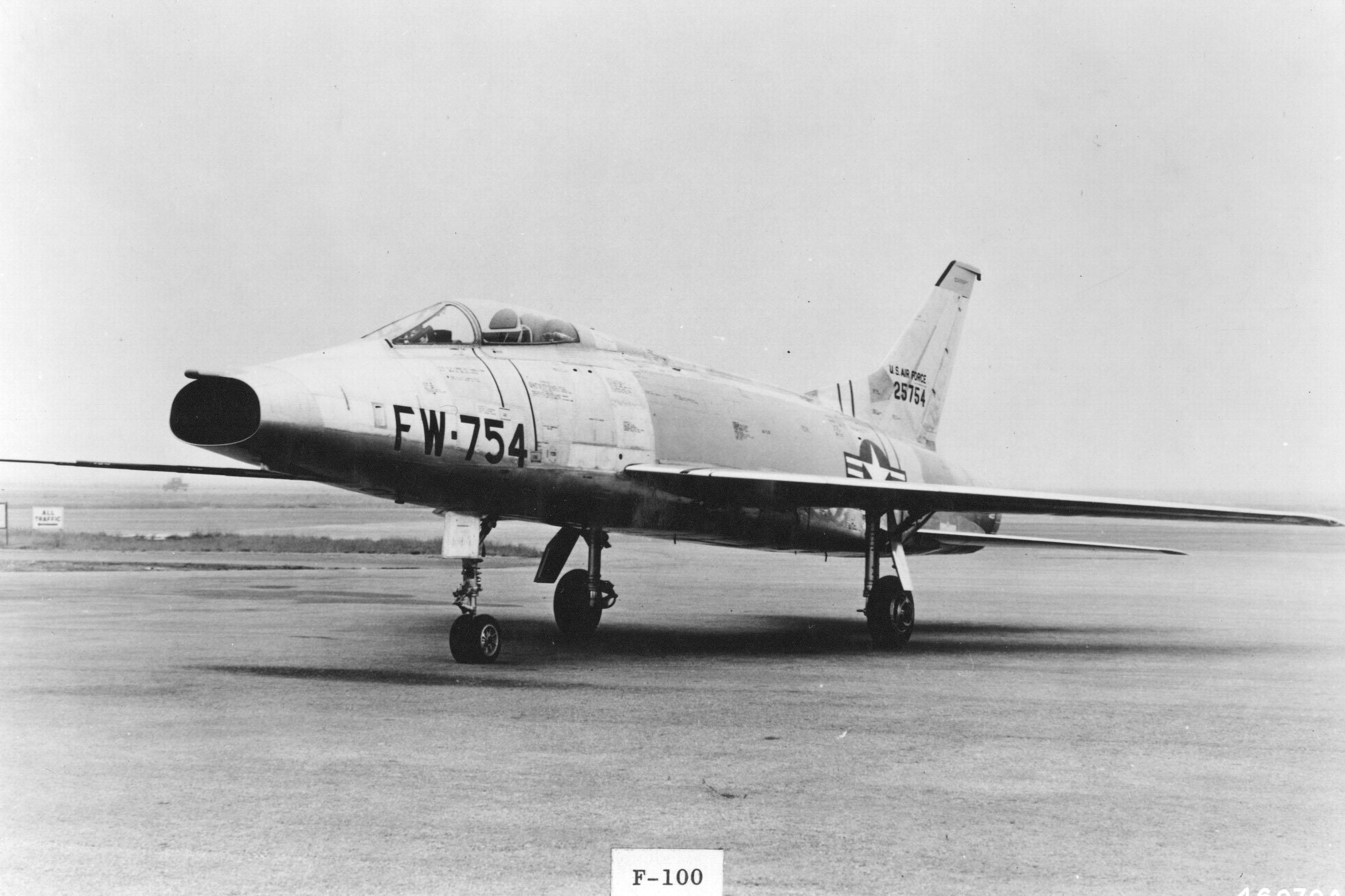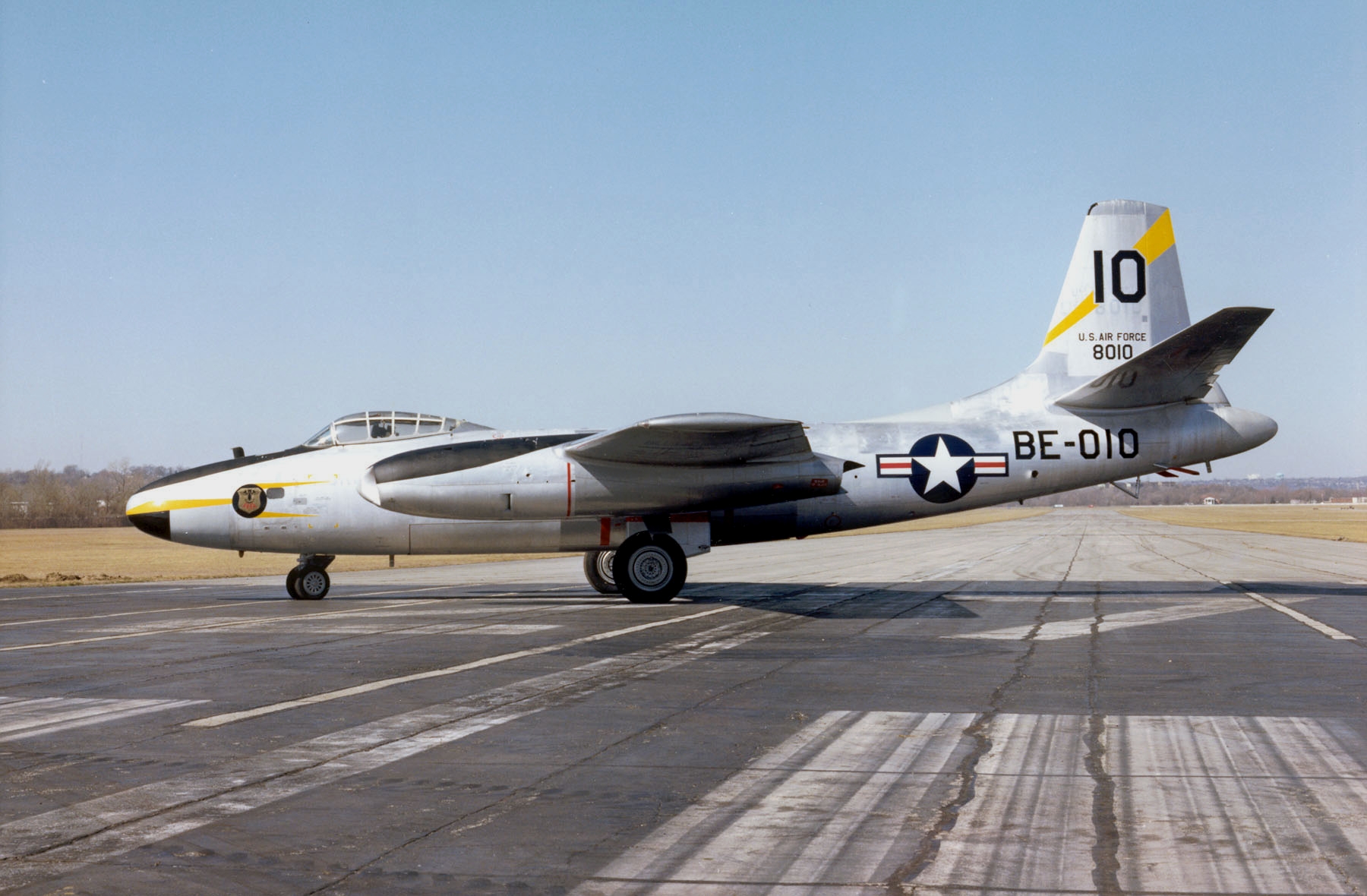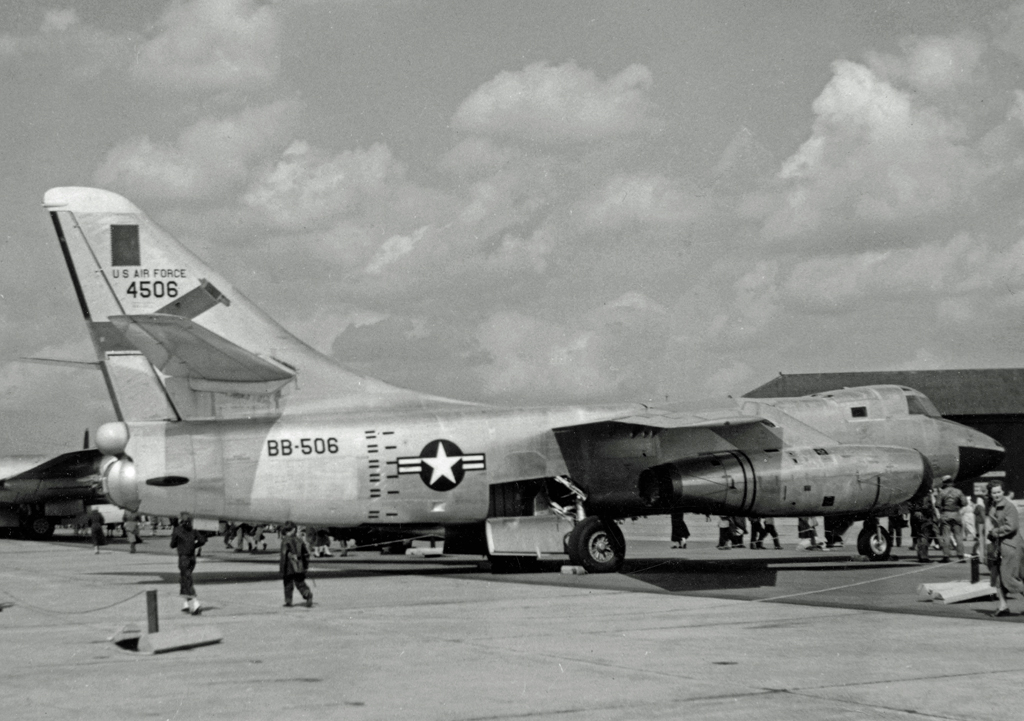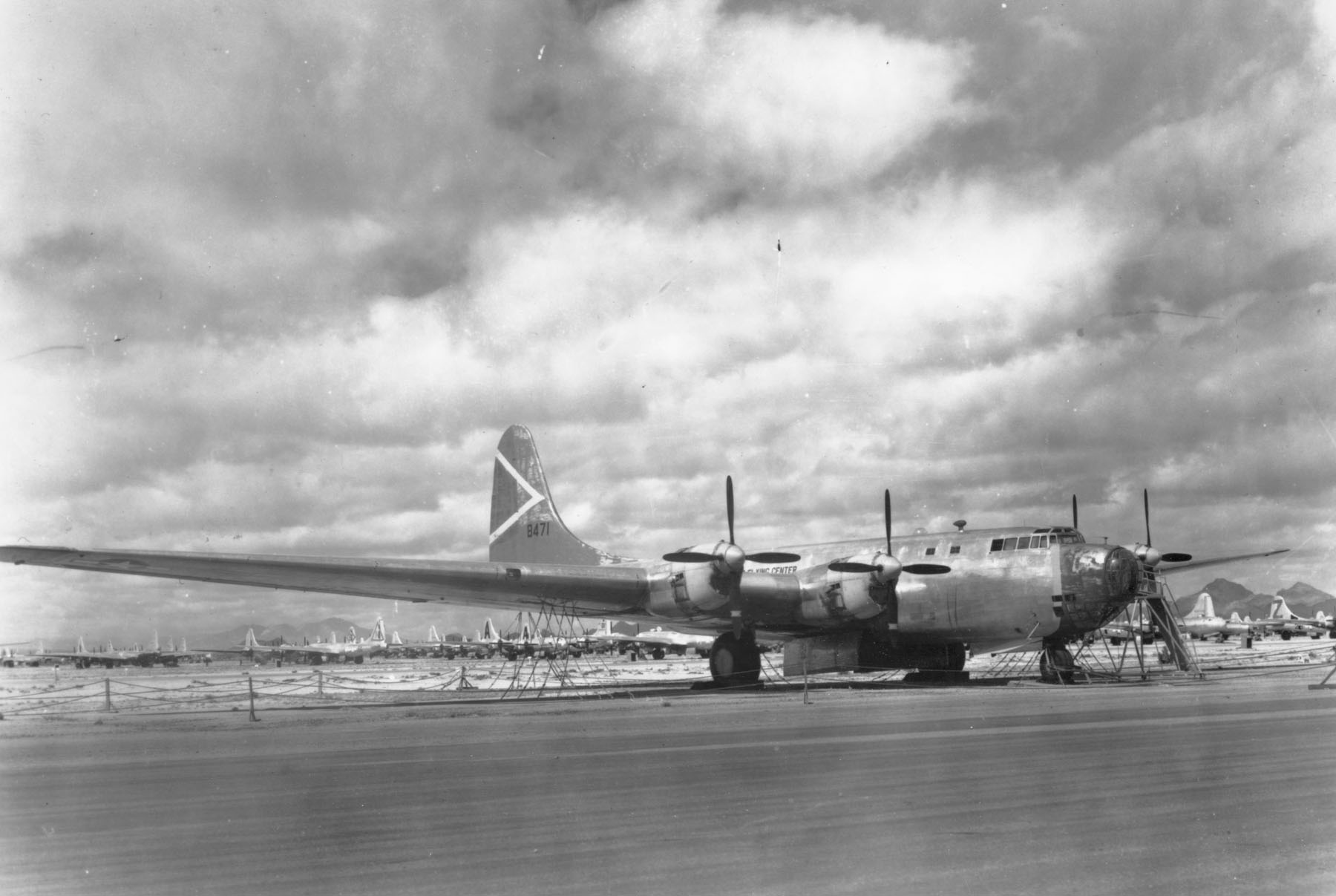|
Buzz Number
Buzz number is a term applied to the large letter and number combination applied to United States Air Force military aircraft in the years immediately after World War II, through the early 1960s. This moniker evolved from aircrew speculation that the large numbers were meant to dissuade "buzzing" (very-low-altitude high-speed passes over populated areas) by increasing the likelihood of being identified and punished. The first two letters of a buzz number indicated the type and designation of an aircraft while the last three were generally the last three digits of the aircraft serial number. Air Force fighters used buzz numbers starting with the letter F (or P, when fighters were designated as "pursuit" aircraft before June 1948), while bombers started with the letter B. For example, a P-51 Mustang would have a buzz number such as FF-230 while an F-86 Sabre might be FU-910. A B-66 Destroyer would have a buzz number such as BB-222. One of the last Air Force fighters to carry a buz ... [...More Info...] [...Related Items...] OR: [Wikipedia] [Google] [Baidu] |
F-100
F-100 or F100 may refer to: Aerospace and defense * North American F-100 Super Sabre, a fighter aircraft formerly in the service of the United States Air Force * Fokker 100, a regional jet * Pratt & Whitney F100, afterburning turbofan engine * ''Álvaro de Bazán''-class frigate (also known as the F100 class), in the service with the Spanish ''Armada Española'' Automotive * Ford F-Series F-100, a pickup truck * Formula F100, a racing class * Daihatsu Hi-Line F100, a model of truck Other uses * F-100 and F-75 (foods), a therapeutic food given to treat severe malnutrition * Ferranti F100-L, a 16-bit microprocessor family from 1976 * Nikon F100 The Nikon F100 is a 35 mm Photographic film, film-based single-lens reflex camera body introduced in 1999. It is often thought of as a scaled-down version of the Nikon F5, and as a precursor to the Nikon F6. The F100 was discontinued, along wi ..., an autofocus 35mm single-lens reflex camera * ESP F-100FM, one of the LTD Standard S ... [...More Info...] [...Related Items...] OR: [Wikipedia] [Google] [Baidu] |
Vultee A-31 Vengeance
The Vultee A-31 Vengeance was an American dive bomber of World War II, built by Vultee Aircraft. A modified version was designated A-35. The Vengeance was not used operationally by the United States, but was operated as a front-line aircraft by the British Royal Air Force, the Royal Australian Air Force, and the Indian Air Force in Southeast Asia and the Southwest Pacific. The A-31 remained in service with U.S. units until 1945, primarily in a target-tug role.Angelucci and Matricardi 1978, p. 69. Design and development In 1940, Vultee Aircraft started the design of a single engined dive-bomber, the Vultee Model 72 (V-72) to meet the requirements of the French ''Armée de l'Air''. The V-72 was built with private funds and was intended for sale to foreign markets. The V-72 was a low-wing, single-engine monoplane with a closed cockpit and a crew of two. An air-cooled radial Wright Twin Cyclone GR-2600-A5B-5 engine rated at powered the V-72. It was armed with both fixed forward- ... [...More Info...] [...Related Items...] OR: [Wikipedia] [Google] [Baidu] |
North American B-45 Tornado
The North American B-45 Tornado was an early American jet bomber designed and manufactured by aircraft company North American Aviation. It has the distinction of being the first operational jet bomber to enter service with the United States Air Force (USAF), as well as the first multiengine jet bomber to be refueled in midair. The B-45 originated from a wartime initiative launched by the U.S. War Department, which sought a company to develop a jet-propelled bomber to equal those being fielded by Nazi Germany, such as the Arado Ar 234. Following a competitive review of the submissions, the War Department issued a contract to North American to develop its ''NA-130'' proposal; on 8 September 1944, work commenced on the assembly of three prototypes. Progress on the program was stalled by post-war cutbacks in defense expenditure, but regained importance due to growing tensions between America and the Soviet Union. On 2 January 1947, North American received a production contract fo ... [...More Info...] [...Related Items...] OR: [Wikipedia] [Google] [Baidu] |
North American B-25 Mitchell
The North American B-25 Mitchell is an American medium bomber that was introduced in 1941 and named in honor of Major General William "Billy" Mitchell, a pioneer of U.S. military aviation. Used by many Allied air forces, the B-25 served in every theater of World War II, and after the war ended, many remained in service, operating across four decades. Produced in numerous variants, nearly 10,000 B-25s were built. These included several limited models such as the F-10 reconnaissance aircraft, the AT-24 crew trainers, and the United States Marine Corps' PBJ-1 patrol bomber. Design and development The Air Corps issued a specification for a medium bomber in March 1939 that was capable of carrying a payload of over at North American Aviation used its NA-40B design to develop the NA-62, which competed for the medium bomber contract. No YB-25 was available for prototype service tests. In September 1939, the Air Corps ordered the NA-62 into production as the B-25, along with the ... [...More Info...] [...Related Items...] OR: [Wikipedia] [Google] [Baidu] |
North American Aviation
North American Aviation (NAA) was a major American aerospace manufacturer that designed and built several notable aircraft and spacecraft. Its products included: the T-6 Texan trainer, the P-51 Mustang fighter, the B-25 Mitchell bomber, the F-86 Sabre jet fighter, the X-15 rocket plane, the XB-70, the B-1 Lancer, the Apollo command and service module, the second stage of the Saturn V rocket, and the Space Shuttle orbiter. Through a series of mergers and sales, North American Aviation became part of North American Rockwell, which later became Rockwell International, and is now part of Boeing. History Early years On December 6, 1928, Clement Melville Keys founded North American as a holding company that bought and sold interests in various airlines and aviation-related companies. However, the Air Mail Act of 1934 forced the breakup of such holding companies. North American became a manufacturing company, run by James H. Kindelberger, James H. "Dutch" Kindelberger, who had bee ... [...More Info...] [...Related Items...] OR: [Wikipedia] [Google] [Baidu] |
Consolidated B-24 Liberator
The Consolidated B-24 Liberator is an American heavy bomber, designed by Consolidated Aircraft of San Diego, California. It was known within the company as the Model 32, and some initial production aircraft were laid down as export models designated as various LB-30s, in the Land Bomber design category. At its inception, the B-24 was a modern design featuring a highly efficient shoulder-mounted, high aspect ratio Davis wing. The wing gave the Liberator a high cruise speed, long range and the ability to carry a heavy bomb load. Early RAF Liberators were the first aircraft to cross the Atlantic Ocean as a matter of routine. In comparison with its contemporaries, the B-24 was relatively difficult to fly and had poor low-speed performance; it also had a lower ceiling and was less robust than the Boeing B-17 Flying Fortress. While aircrews tended to prefer the B-17, General Staff favored the B-24 and procured it in huge numbers for a wide variety of roles. At approximately 18,5 ... [...More Info...] [...Related Items...] OR: [Wikipedia] [Google] [Baidu] |
Consolidated Aircraft
The Consolidated Aircraft Corporation was founded in 1923 in aviation, 1923 by Reuben H. Fleet in Buffalo, New York, the result of the Gallaudet Aircraft Company's liquidation and Fleet's purchase of designs from the Dayton-Wright Company as the subsidiary was being closed by its parent corporation, General Motors.Yenne 2009, p. 15. Consolidated became famous, during the 1920s and 1930s, for its line of flying boats. The most successful of the Consolidated patrol boats was the PBY Catalina, which was produced throughout World War II and used extensively by the Allies. Equally famous was the B-24 Liberator, a heavy bomber which, like the Catalina, saw action in both the Asiatic-Pacific Theater, Pacific and European Theater of Operations, European theaters. In 1943 in aviation, 1943, Consolidated merged with Vultee Aircraft to form Consolidated-Vultee Aircraft, later known as Convair. History Consolidated Aircraft (and later Convair) had their headquarters in San Diego, California, ... [...More Info...] [...Related Items...] OR: [Wikipedia] [Google] [Baidu] |
Douglas B-66 Destroyer
The Douglas B-66 Destroyer is a light bomber that was designed and produced by the American aviation manufacturer Douglas Aircraft Company. The B-66 was developed for the United States Air Force (USAF) and is heavily based upon the United States Navy's A-3 Skywarrior, a heavy carrier-based attack aircraft. Originally, officials intended for the aircraft to be a simple development of the earlier A-3, taking advantage of being strictly land-based to dispense with unnecessary naval features. However, due to the USAF producing extensive and substantially divergent requirements, it became necessary to make considerable alterations to the design, leading to a substantial proportion of the B-66 being original rather than derived from the A-3. The B-66 retained the three-man crew arrangement of the US Navy's A-3; differences included the incorporation of ejection seats, which the A-3 had lacked. Performing its maiden flight on 28 June 1954, the aircraft was introduced to USAF servic ... [...More Info...] [...Related Items...] OR: [Wikipedia] [Google] [Baidu] |
Douglas XB-19
The Douglas XB-19 was a four-engined, piston-driven heavy bomber produced by the Douglas Aircraft Company for the United States Army Air Forces (USAAF) during the early 1940s. It was the largest bomber built for the USAAF until 1946, and was originally given the designation XBLR-2 (''XBLR'' denoting "Experimental Bomber Long Range"). Design and development The XB-19 project was intended to test flight characteristics and design techniques for giant bombers. Despite advances in technology that made the XB-19 obsolete before it was completed, the Army Air Corps believed the prototype would be useful for testing despite Douglas Aircraft wanting to cancel the expensive project. Its construction took so long that competition for the contracts to build the XB-35 and XB-36 occurred two months before its first flight. The plane first flew on 27 June 1941, more than three years after the construction contract was awarded. It was based at Wright Field from January to November 1942. In ... [...More Info...] [...Related Items...] OR: [Wikipedia] [Google] [Baidu] |
Martin B-57 Canberra
The Martin B-57 Canberra is an American-built, twin-engined tactical bomber and reconnaissance aircraft that entered service with the United States Air Force (USAF) in 1953. The B-57 is a license-built version of the British English Electric Canberra, manufactured by the Glenn L. Martin Company. Initial Martin-built models were virtually identical to their British-built twinjet counterparts; Martin later modified the design to incorporate larger quantities of US-sourced components and produced the aircraft in several different variants. The B-57 Canberra holds the distinction of being the first jet bomber in U.S. service to drop bombs during combat. The Canberra was used extensively during the Vietnam War in a bombing capacity; dedicated versions of the type were also produced and served as high-altitude aerial reconnaissance platforms (the Martin RB-57D Canberra), and as electronic warfare aircraft. The B-57 Canberra was also sold to export customers abroad; further combat us ... [...More Info...] [...Related Items...] OR: [Wikipedia] [Google] [Baidu] |
Martin Aircraft
The Glenn L. Martin Company—also known as The Martin Company from 1957-1961—was an American aircraft and aerospace manufacturing company founded by aviation pioneer Glenn L. Martin, and operated between 1917-1961. The Martin Company produced many important aircraft for the defense of the US and allies, especially during World War II and the Cold War. During the 1950s and 60s, the Martin Company moved from the aircraft industry into the guided missile, space exploration, and space utilization industries. In 1961, the Martin Company merged with American-Marietta Corporation, a large industrial conglomerate, forming Martin Marietta Corporation. In 1995, Martin Marietta merged with aerospace giant Lockheed to form the Lockheed Martin Corporation."Lockheed Martin History." ''lockheedmartin.com.'' Retrieve ... [...More Info...] [...Related Items...] OR: [Wikipedia] [Google] [Baidu] |
Boeing B-17 Flying Fortress
The Boeing B-17 Flying Fortress is a four-engined heavy bomber developed in the 1930s for the United States Army Air Corps (USAAC). Relatively fast and high-flying for a bomber of its era, the B-17 was used primarily in the European Theater of Operations and dropped more bombs than any other aircraft during World War II. It is the third-most produced bomber of all time, behind the four-engined Consolidated B-24 Liberator and the multirole, twin-engined Junkers Ju 88. It was also employed as a transport, antisubmarine aircraft, drone controller, and search-and-rescue aircraft. In a USAAC competition, Boeing's prototype Model 299/XB-17 outperformed two other entries but crashed, losing the initial 200-bomber contract to the Douglas B-18 Bolo. Still, the Air Corps ordered 13 more B-17s for further evaluation, then introduced it into service in 1938. The B-17 evolved through numerous design advances but from its inception, the USAAC (later, the USAAF) promoted the aircraft a ... [...More Info...] [...Related Items...] OR: [Wikipedia] [Google] [Baidu] |

_DS.jpg)




.jpg)




